Trucker Access › Forums › Diesel News › Kenworth SuperTruck 2 Looks to the Future – Equipment
- This topic has 0 replies, 1 voice, and was last updated 11 months ago by
 EazyRiDer66.
EazyRiDer66.
-
AuthorPosts
-
May 22, 2024 at 5:15 am #21601
 EazyRiDer66Keymaster
EazyRiDer66Keymaster
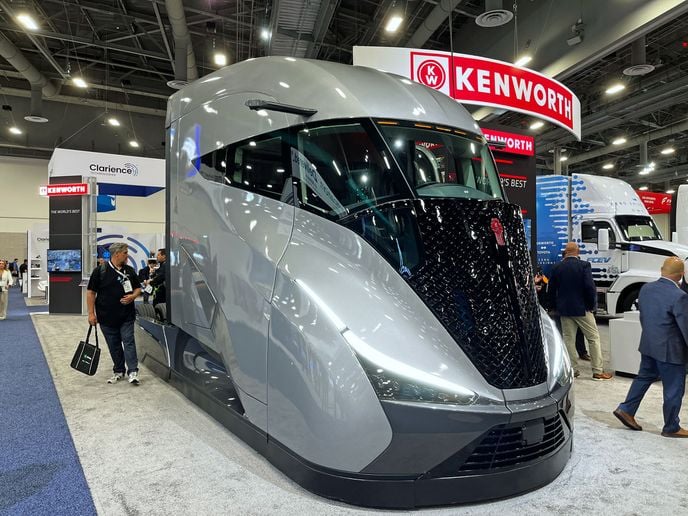
The unique look of Kenworth’s SuperTruck 2 features a “center driver” cab, along with a new sleeper compartment. It’s a look that resembles a bullet train.
Kenworth engineers asked themselves, “What does the next-generation vehicle for long-haul transportation look like?” Their answer was the SuperTruck 2 freight-efficiency demonstrator at ACT Expo in Las Vegas — arguably the most futuristic-looking of the Department of Energy’s SuperTruck 2 projects.
Kenworth’s SuperTruck 2 demonstrator didn’t just look cool; it improved freight efficiency over the base model by as much as 136%, with fuel economy numbers nearing 13 mpg.
The truck was developed over a six-year period as part of a collaboration with the Department of Energy’s SuperTruck program, designed to challenge truck makers to improve freight efficiency using a diesel engine as the main power source.
“The goal was a 100% freight efficiency improvement over our 2009 Kenworth T660, which at the time was arguably the most fuel-efficient truck in the industry,” said Jim Walenczak, general manager of Kenworth and Paccar vice president. “We surpassed the performance of that model to improve efficiency by up to 136%.”
This was achieved by improving fuel efficiency up to 12.8 mpg while reducing the combination weight by more than 7,000 pounds. The result was the ability to haul more payload with an ultra-fuel-efficient tractor-trailer combination.
“SuperTruck 2 provided us with the opportunity to investigate new technologies in an early stage. We learned what worked and what didn’t,” Walenczak said. “As a result, we are able to commercialize new technologies much quicker than we would have otherwise.”
‘What Does the Next-Generation Vehicle for Long-Haul Transportation Look Like?’
“We started with an ideal aerodynamic shape when we started the design of SuperTruck 2,” said Joe Adams, Kenworth’s chief engineer.
“At the start of the project, we asked ourselves, ‘What does the next generation vehicle for long haul transportation look like?’ What we produced pushes the limits in reducing aerodynamic drag while it also incorporates a new powertrain.
“But, with everything Kenworth, we wanted the SuperTruck 2 to embody ‘The Driver’s Truck’. The result was a systematic approach to developing a futuristic-looking, yet relevant vehicle with technologies that have the potential to be refined and commercialized.”
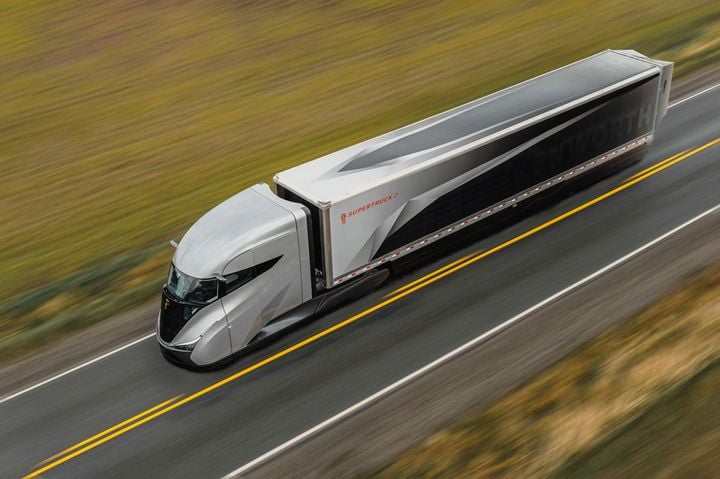
Kenworth compares the look of its SuperTruck 2 demonstrator to a bullet train.
Kenworth’s SuperTruck 2 Powertrain
Kenworth’s SuperTruck 2 uses a Paccar MX-11 engine, rated at 440 hp, which is driven through a Paccar TX-12 automated transmission.
In addition, the truck features a 48-volt electric generator. This creates a “mild” hybrid system and leverages next-generation lithium-ion batteries that are recharged through regenerative braking. This allows Kenworth’s SuperTruck 2 to operate electric fans, electric steering, and power for electric coolant and HVAC pumps, which were previously mechanically driven and caused parasitic energy loss. The engine fan alone can draw up to 80 horsepower.
The hybrid system also provides an overnight engine-off “hoteling” solution. In addition, the 48V generator powers the exhaust heater in the in-house-developed close coupled aftertreatment system, which demonstrated CARB 2027 ultra-low NOx compliancy.
The SuperTruck 2 team conducted a parallel project for energy efficiency testing by combining a Paccar MX-11 based engine, the mild hybrid-based 48-volt auxiliaries, and energy waste recovery to achieve 55.7% engine efficiency on a test stand.
“We did this while keeping in mind the technologies we developed needed to be commercially viable,” said Maarten Meijer, Paccar’s senior engineering manager for advanced technology.
“Today’s modern diesel engine demonstrates around 47% efficiency. Reaching 55.7% was a major step forward and could only be done by applying new technologies that had not been explored until today,” he said.
“To put that efficiency number into perspective, if this engine were to go into production, it would lead to a 10% fuel efficiency improvement. That’s an astonishing number.”
Center-Driver Cab Creates Bullet-Train Look for Kenworth SuperTruck 2
The unique look of Kenworth’s SuperTruck 2 features a “center driver” cab, along with a new sleeper compartment. It’s a look that resembles a bullet train.
“We wanted to push this beyond just a demonstrator truck,” said Jonathan Duncan, Kenworth’s design director. “We wanted to show something dynamic and what the future of Kenworth might look like.
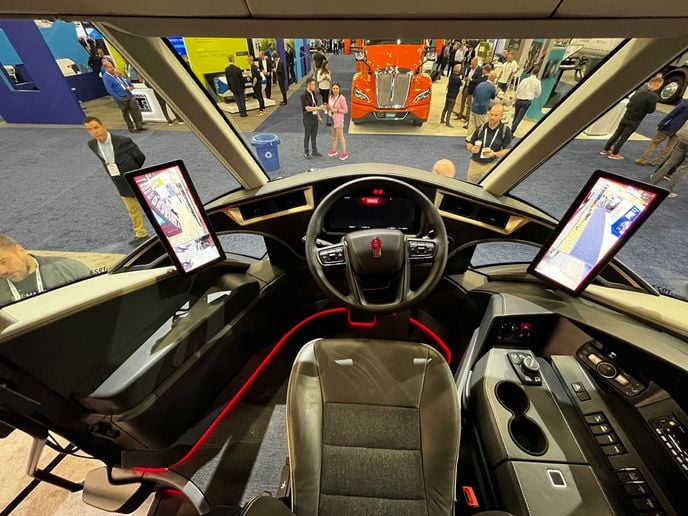
A driver of the Kenworth SuperTruck 2 has an expansive view through the very parabolic windshield, which helps smooth the air flow over the tractor.
“Our headlamps take up the entire front fender of the truck. It’s striking — you can’t miss it as it’s going down the road.”
The aerodynamic design was enabled in part by the location of the powertrain content, which fits between the frame rails. This also allowed the engine to be lowered and placed behind the front axle.
A reverse-splayed chassis allowed the engineering team to narrow the front of the truck and fully enclose the wheels within the bodywork. The entire hood and the chassis fairings were mounted directly to the cab, and they move with the entire cab as one unit.
A variable suspension system was developed to customize ride height and optimize aerodynamics. Kenworth’s SuperTruck 2 can be raised over rough roads to avoid obstacles, then brought back down when running over smoother interstates.
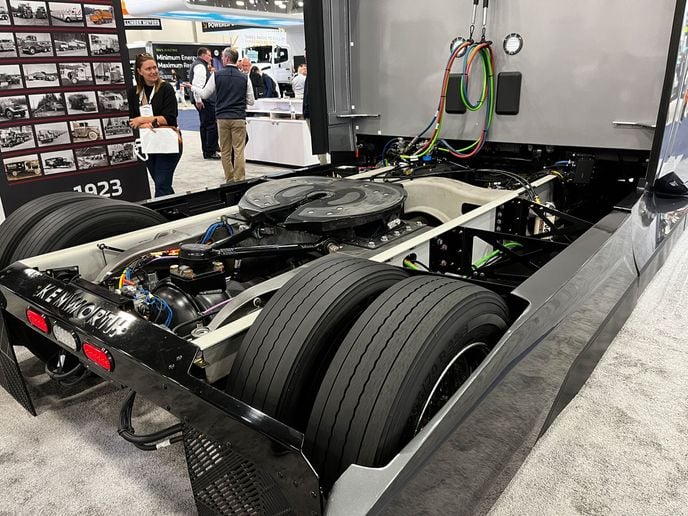
A variable suspension system was developed to customize ride height and optimize aerodynamics.
Combined, the sleekness means a 48% reduction in drag as compared to Kenworth’s baseline vehicle.
Even though SuperTruck 2 is powered by a diesel engine, Kenworth is thinking toward the future. The overall layout was designed to be powertrain-agnostic. To support zero and near-zero emission solutions, the truck can efficiently package fuel cells, hydrogen tanks, natural gas tanks, or batteries without changing the basic cab.
More Payload Capacity = More Freight Efficiency
Enabling more payload was a critical element for the Kenworth engineering team, which also used a design-specific trailer to go with the tractor. The combination came in at 26,100 pounds – 7,100 pounds less than a typical tractor-trailer configuration (4,100-pound savings on the tractor; 3,000 on the trailer).
“These savings would give a fleet the option of running lighter with the same amount of goods they’d normally put in a trailer, or they could add 7,100 more pounds of payload,” said Adams.
There were a lot of things that contributed to weight savings, he said.
The 10 new concept tires weighed 355 pounds less than ‘like’ tires currently on the market, and those tires also had an extremely low rolling resistance – measuring 4.2 on the CRR scale (rolling resistance coefficient) versus 5.0 for typical high-efficiency tires, according to Kenworth.
“We also found that less fuel was required with the more fuel-efficient powertrain,” Adams said. “This allowed us to put on a smaller 80-gallon fuel tank to go the same distance as before. So, here again, we’re saving weight. It all builds upon itself.”
Inside the Cab of the Kenworth SuperTruck 2
Climbing into the truck, the driver-side door has a large opening, and the extendable bottom step supports a stairway-like entry and exit.
SuperTruck 2 features Paccar’s new 15-inch digital display, with a configurable gauge layout, advanced driver notifications, and a user-friendly menu navigation.
Once behind the wheel, drivers have a view through the very parabolic windshield, which helps smooth the air flow over the tractor.
Like others in the SuperTruck 2 program, Kenworth eliminated physical mirrors altogether, minimizing drag further. The integrated digital mirror system enables enhanced rearview monitoring, with trailer tracking capability and night vision enhancements, technology currently available in Kenworth T680 models.
For drivers off hours, Kenworth took the extra step to design a unique sleeper berth.
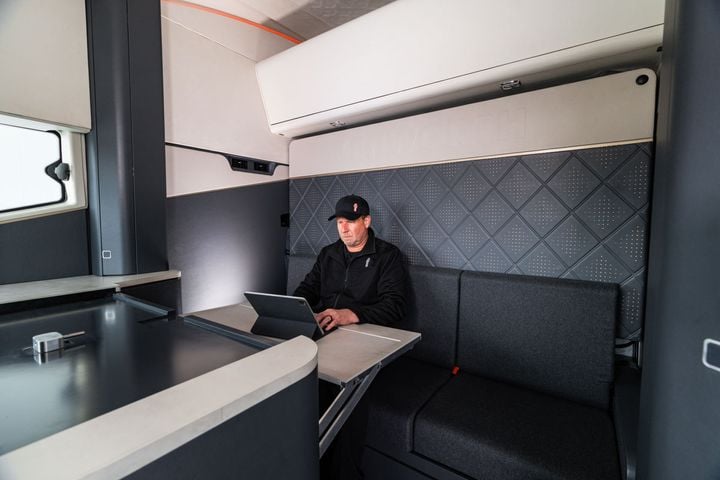
The SuperTruck 2 sleeper features a tabletop that rotates down when you’re sitting on the sofa.
“One of the features we’re trialing is a bed that folds down over the sofa,” said Duncan. “This provides a separate sleeping and sitting area.
“We also came up with a neat concept: having a tabletop that rotates down when you’re sitting on the sofa. You can actually eat or work then move the table to a different location without moving anything off the tabletop.”
In addition to Kenworth’s public-private partnership with the DOE, the following companies and institutions provided product and research development for the SuperTruck 2 program: AVL (engine development), Eaton (powertrain development), the National Renewable Energy Laboratory, and The Ohio State University.
At ACT Expo, Kenworth also is showcasing its lineup of zero-emissions transportation solutions, including the T680 hydrogen fuel cell electric vehicle and T680E battery electric vehicle.
Kenworth will also display the K270E BEV and offer a ride and drive opportunity for customers to experience the T680 FCEV and X15N natural-gas powered T680.
-
AuthorPosts
- You must be logged in to reply to this topic.